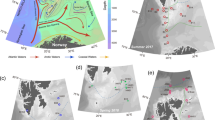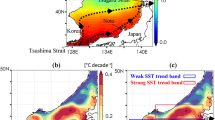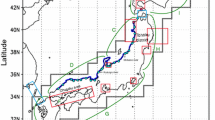Abstract
Rivers transport nutrients and suspended sediment matter (SSM) as well as fresh water from land to coastal regions, where the biological productivity is high. In the coastal area, the buoyancy of fresh water leads to the formation of horizontal anticyclonic gyres and vertical circulations, which affect the variation of biological production such as plankton blooms. However, the primary production caused by the 3-D dynamics have not been quantitatively discussed, and observations can hardly capture the daily temporal variations of phytoplankton blooms. We developed an ocean general circulation model including a simple ecosystem model, to investigate the 3-D and temporal changes in phytoplankton blooms caused by riverine input such as flooding. The distribution patterns of nutrients and phytoplankton differ significantly from that of fresh water. The phytoplankton maxima shift from the downstream (right-hand side of the river mouth) to the upstream regions (left-hand side of the river mouth). The shift that occurs is categorized by the different nitrate origins: (1) river-originated nitrate is dominant in the downstream region; (2) subsurface-originated nitrate is dominant in the upstream region, and is transported by upwelling associated with vertical circulation and horizontal anticyclonic gyre; and (3) regenerated nitrate is dominant in the upstream region. The total primary production in phytoplankton blooms is maintained not only by river-originated nitrate but also by subsurface-originated nitrate that is 1.5 times larger than the river-originated. Several case studies (e.g., including SSM) were conducted in this study.















Similar content being viewed by others
References
Agboola JI, Yoshi S, Kudo I (2009) Seasonal change of riverine nutrients and distribution of chlorophyll a in Ishikari Bay, subarctic oligotrophic coastal environment of Japan. La mer 47:1–17
A-line data home page (2012). Fisheries Research Agency, Hokkaido and Tohoku Institute. http://hnf.fra.affrc.go.jp/a-line/data/nutri/Data_aline0001-0710.csv. Accessed 28 September 2012
Beardsley RC, Limeburner R, Hu D, Le K, Cannon GA (1985) Discharge of the Changjiang (Yangtze river) into the East China sea. Cont Shelf Res 4:57–76
Beman JM, Arrigo KR, Matson PA (2005) Agricultural runoff fuels large phytoplankton blooms in vulnerable areas of the ocean. Nature 434:211–214
Bowden KF (1983) Physical oceanography of coastal waters. Wiley, New York
Chao S-Y, Boicourt WC (1986) Onset of estuarine plumes. J Phys Oceanogr 16:2137–2149
Chapman DC, Lentz SJ (1994) Trapping of a coastal density front by bottom boundary layer. J Phys Oceanogr 24:1464–1479
Costanza R, d’Arge R, de Groot R, Farber S, Grasso M, Hannon B et al (1997) The value of the world’s ecosystem services and natural capital. Nature 387:253–260
Garvine RW (2001) The impact of model configuration in studies of buoyant coastal discharge. J Mar Res 59:193–225
Griffies SM, Hallberg RW (2000) Biharmonic friction with a Smagorinsky-like viscosity for use in large-scale eddy-permitting ocean models. Mon Wea Rev 128:2935–2946
Hasumi H (2002) Sensitivity of the global thermohaline circulation to interbasin freshwater transport by the atmosphere and the Bering Strait through-flow. J Climate 15:2516–2526
Ileva NY, Shibata H, Satoh F, Sasa K, Ueda H (2009) Relationship between the riverine nitrate-nitrogen concentration and the land use in the Teshio River watershed, North Japan. Sust Sci 4:189–198
Isobe A (2005) Ballooning of river-plume bulge and its stabilization by tidal currents. J Phys Oceanogr 35:2337–2351
Kaiser MJ, Attrill MJ, Jennings S, Thomas DN, Barnes DKA, Brierley AS, Hiddink JG, Kaartokallio H, Polunin NVC, Raffaelli DG (2005) Marine ecology: processes, systems, and impacts. Oxford University Press, New York
Kubokawa A (1991) On the behavior of outflows with low potential vorticity from a sea strait. Tellus 43A:168–176
Kudo I, Yoshimura T, Lee CW, Yanada M, Maita Y (2007) Nutrient regeneration at bottom after a massive spring bloom in a subarctic coastal environment, Funka Bay, Japan. J Oceanogr 63:791–801
Kusuda T (2003) Aquatic environment in estuaries (in Japanese). J Jpn River Assoc ‘KASEN’ 680:20–26
Kusuda T, Koga K, Awaya Y (1978) Aggregation of clay particles in salty water (in Japanese). J Water Waste 20:295–300
Le VS, Yamashita T, Okunishi T, Shinohara R, Miyatake M (2006) Characteristics of suspended sediment material transport in the Ishikari Bay in snowmelt season. Appl Ocean Res 28:275–289
Leonard BP (1979) A stable and accurate convective modeling procedure based upon quadratic upstream interpolation. Comp Meth Appl Mech Eng 19:59–98
Leonard BP, MacVean MK, Lock AP (1993) Positivity-preserving numerical schemes for multidimensional advection. NASA Tech Memo 106055
Lihan T, Saitoh S, Iida T, Hirawake T, Iida K (2008) Satellite-measured temporal and spatial variability of the Tokachi river plume. Est Coast Shelf Sci 78:237–249
Magome S, Isobe A (2003) Current structure and behavior of the river plume in Suo-Nada. J Oceanogr 59:833–843
Matano PR, Palma ED (2010) The upstream spreading of bottom-trapped plumes. J Phys Oceanogr 40:1631–1650
McCreary JP, Zhang S, Shetye SR (1997) Coastal circulations driven by river outflow in variable-density 1½-layer model. J Geophys Res 102:15535–15554
Murty VSN, Sarma YVB, Rao DP, Murty CS (1992) Water characteristics, mixing and circulation in the Bay of Bengal during southwest monsoons. J Mar Res 50:207–228
Nijssen B, O’Donnell GM, Hamlet AF, Lettenmaier DP (2001) Hydrologic sensitivity of global rivers to climate change. Clim Chan 50:143–175
Nof D, Pichevin T (2001) The ballooning of outflows. J Phys Oceanogr 31:3045–3058
Pimenta FM, Kirwan AD, Huq P (2011) On the transport of buoyant coastal plumes. J Phys Oceanogr 41:620–640
Piola AR, Romero SI, Zajaczkovski U (2008) Space-time variability of the Plata plume inferred from ocean color. Cont Shelf Res 28:1556–1567
Rattray M, Hansen DV (1962) A similarity solution for circulation in an estuary. J Mar Res 20:121–133
Simpson JH (1997) Physical processes in the ROFI regime. J Mar Sys 12:3–15
Tachibana H, Yamamoto K, Yoshizawa K, Magara Y (2001) Non-point pollution of Ishikari river, Hokkaido, Japan. Water Sci Technol 44(7):1–8
Tokachi River discharge from Water Information System (2012). Ministry of Land, Infrastructure and Transport, Japan. http://www1.river.go.jp/cgi-bin/DspWaterData.exe?KIND=7&ID=301081281107070&BGNDATE=20060131&ENDDATE=20061231&KAWABOU=NO. Accessed 14 September 2012
Tsujino H, Hasumi H, Suginohara N (2000) Deep pacific circulation controlled by vertical diffusivity at the lower thermocline depths. J Phys Oceanogr 30:2853–2865
Usui T, Nagao S, Yamamoto M, Suzuki K, Kudo I, Montani S, Noda A, Minagawa M (2006) Distribution and sources of organic matter in surficial sediments on the shelf and slope off Tokachi, western North Pacific, inferred from C and N stable isotopes and C/N ratios. Mar Chem 98:241–259
Walker ND, Fargion GS, Rouse LJ, Biggs DC (1994) The great flood of summer 1993: Mississippi river discharge studied. EOS Trans AGU 75:409
Weingartner TJ, Danielson S, Sasaki Y, Pavlov V, Kulakov M (1999) The Siberian coastal current: a wind and buoyant-forced Arctic coastal current. J Geophys Res 104:29697–29713
Yamamoto T, Hashimoto T (2007) Estuarine circulation and primary production (in Japanese with English abstract). Bull Coast Oceanogr 44:137–145
Yankovsky AE (2000) The cyclonic turning and propagation of buoyant coastal discharge along the shelf. J Mar Res 58:585–607
Yoshikawa C, Yamanaka Y, Nakatsuka T (2005) An ecosystem model including nitrogen isotopes: perspectives on a study of the marine nitrogen cycle. J Oceanogr 61:921–942
Yoshimura T, Kudo I (2011) Seasonal phosphorus depletion and microbial response to the change in phosphorus availability in a subarctic coastal environment. Mar Chem 126:182–192
Acknowledgments
We deeply thank to Dr. Genta Mizuta of the Faculty of Environmental Earth Science, Hokkaido University for helping with the model settings and discussions. We are very grateful to Dr. Atsushi Kubokawa, Dr. Isao Kudo and Dr. Tomohisa Irino of the Faculty of Environmental Earth Science, Hokkaido University for discussing the physics of river plumes, advising on biogeochemical cycle in ROFI and providing the information on empirical coefficients in Tokachi River, respectively. We would also like to thank to Dr. Yutaka Isoda of the Faculty of Fisheries Sciences, Hokkaido University for discussing the physics of ROFI. Yasuhiro Hoshiba was supported by the Grant-in-Aid for the Global COE Program from MEXT and by Development of mitigation and adaptation techniques to global warming in the sectors of agriculture, forestry, and fisheries as a research assistant. Yasuhiro Yamanaka was also supported by Core Research for Evolutional Science and Technology (CREST), Japan Science and Technology Agency (JST).
Author information
Authors and Affiliations
Corresponding author
Rights and permissions
About this article
Cite this article
Hoshiba, Y., Yamanaka, Y. Along-coast shifts of plankton blooms driven by riverine inputs of nutrients and fresh water onto the coastal shelf: a model simulation. J Oceanogr 69, 753–767 (2013). https://doi.org/10.1007/s10872-013-0206-4
Received:
Revised:
Accepted:
Published:
Issue Date:
DOI: https://doi.org/10.1007/s10872-013-0206-4




